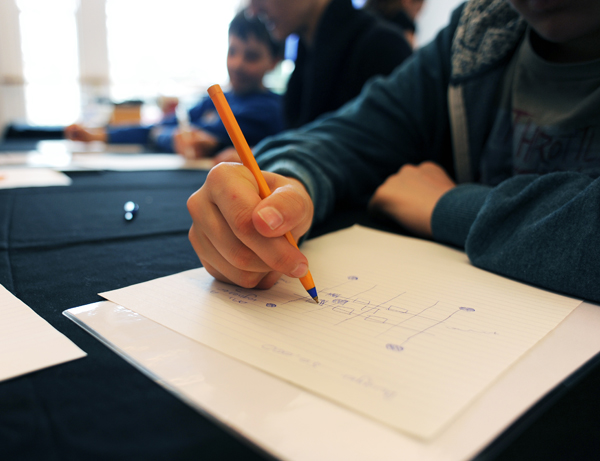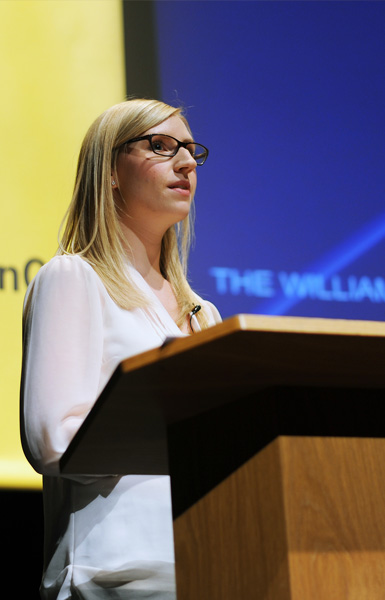Over two days, speakers from a broad range of engineering disciplines showcased their work, including Kirsty Pinnell, Composite Design Engineer at Williams F1, Mark Champkins, Inventor-in Residence at the Science Museum, Alex Heslop and Richard Woolley of Jaguar Land Rover and Chris Bee from the Rutherford Appleton Laboratory.
 The Festival celebrates ‘how original thought can change the world’ and its organisers, the Cheltenham Design Foundation, also run the Design Academy, a free Saturday school run throughout the year which takes 14-16 year-olds through modules covering graphics, photography, engineering and architecture. An exhibition of their work was on display at the Festival. STEM-themed workshops for children aged 7-16, covering photography, space exploration, aviation and designing C++ software, were also held over the weekend, attracting over 80 young people.
The Festival celebrates ‘how original thought can change the world’ and its organisers, the Cheltenham Design Foundation, also run the Design Academy, a free Saturday school run throughout the year which takes 14-16 year-olds through modules covering graphics, photography, engineering and architecture. An exhibition of their work was on display at the Festival. STEM-themed workshops for children aged 7-16, covering photography, space exploration, aviation and designing C++ software, were also held over the weekend, attracting over 80 young people.
A whistle-stop history of space exploration from Chris Bee, Head of Business Development for RAL Space, kicked things off on Saturday morning, following a day focusing on design on Friday 4 April. Chris presented RAL’s input into spacecraft components and infrastructure, providing a comprehensive overview but still keeping it accessible for the young members of the audience, reminding them that: “Space technology drives innovation in all sorts of other ways.”
Chris then focused on the James Webb Space Telescope, a collaboration between UK, European, US and Canadian organisations which will replace the Hubble Space Telescope. He addressed how the launcher requires its mirror to be folded ‘like a ship in a bottle’ for the 1.5m km journey into space. Chris also introduced the young audience to the idea that: “Engineering is mundane,” addressing how projects progress through testing, reviews and managing other teams.
Compared to the 12 year-plus lead times for space exploration, projects which go from design to obsolescence in 20 months, as Williams Formula One cars do, are incredibly quick.

Kirsty Pinnell is a Composite Design Engineer at Williams and has been a Science and Engineering Ambassador for STEMnet and Science Oxford since 2009. Talking about her student days, Kirsty sees engineering as “One of the most interesting careers you can have,” and brought to life the range of career paths available within engineering and the challenges and rewards it can bring.As a composites engineer, Kirsty is responsible for developing several components on the current Williams Mercedes FW36 and took the packed auditorium of almost 300 people through design principles and her pride at directly seeing her impact on the Williams car.
Kirsty said: “I am passionate about encouraging young people into STEM careers. I was delighted to be approached by Malcolm Chapman MIMechE about participating in the Festival and saw it as the ideal opportunity to get my message across to a larger group of people than usual. The more I looked into the Festival, the more excited I became about being part of such a wonderful event that aims to inspire children and young people alike to be creative, inquisitive and innovative.”
This year there were more women than men on the team’s design placements and Kirsty sees this as a great step forward for gender balance in the profession:
“I get a great response from young women who are interested in a career like mine. It helps that they can identify with me as I was once in their position. Unfortunately, women engineers are still few and far between so I think it is very useful when female students can talk to someone of their own gender about their worries, concerns, hopes and expectations about becoming a female engineer. For me, it is still about breaking down the stereotypes that still exist in schools and showing the girls that you don’t have to be a ‘petrolhead’ male to be an F1 Design Engineer!”
She emphasised the importance of communication in innovation while working across design, testing, performance and safety: “For me, the key principle of effective design is communication. Communication is vital in F1 design - from the aerodynamics department, to the designers, to production, to the race team, and sometimes even the drivers get involved! Ensuring you have the full picture before you start a design isn't always possible, but it is important that the effort is there to fully understand the problem before you try to solve it. My head of department has always encouraged me to talk to the necessary people and communicate my concepts and ideas with them before setting anything in stone and this has definitely helped me evolve and grow as an engineer over the past seven years.”
This theme was also picked up in the manufacturing success story of the all-new Range Rover from Jaguar Land Rover. Chief Designer Richard Woolley and Chief Engineer Alex Heslop MIMechE talked a packed room through the product development story, where they integrate their design strategy with customer research, emphasising the importance of emotion in customer loyalty. Customer research suggested the brief for the new car was: “Don’t change it, just make it better,” and JLR focused resources on developing sustainability, capability and refinement.
With 24hr production, six days a week, the all-new Range Rover is contributing to the automotive sector’s £6bn quarterly turnover in the West Midlands alone, with 80% of their production being exported. Weight reduction and fuel economy have massively improved in the fourth generation model, with the aluminium shell weighing 150kg less and engine savings of 420kg.
The final engineering-themed talk was given by the inventor Mark Champkins, who introduced his seven tips for product innovation. From simply observing your environment so that you are in the right state to notice opportunities, to developing knowledge of manufacturing processes to understand the limits of possibility, to starting with the extraordinary idea and tinkering and testing - Mark’s talk could have been a guide for an innovative engineer in their early career, focusing on the inquisitive mentality and creativity required to solve engineering problems across any sector.
Read more about the Festival and see more of the creativity unleashed at the student workshops at http://www.cheltenhamdesignfestival.com
Photography by Lucy Wilmer, courtesy of Cheltenham Design Festival.